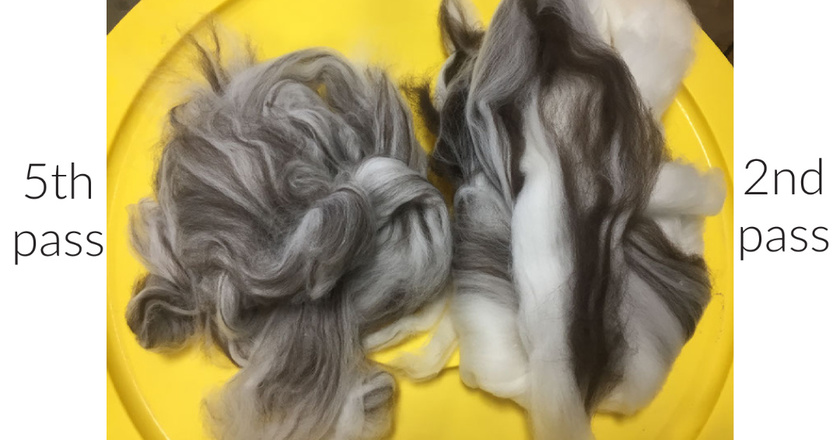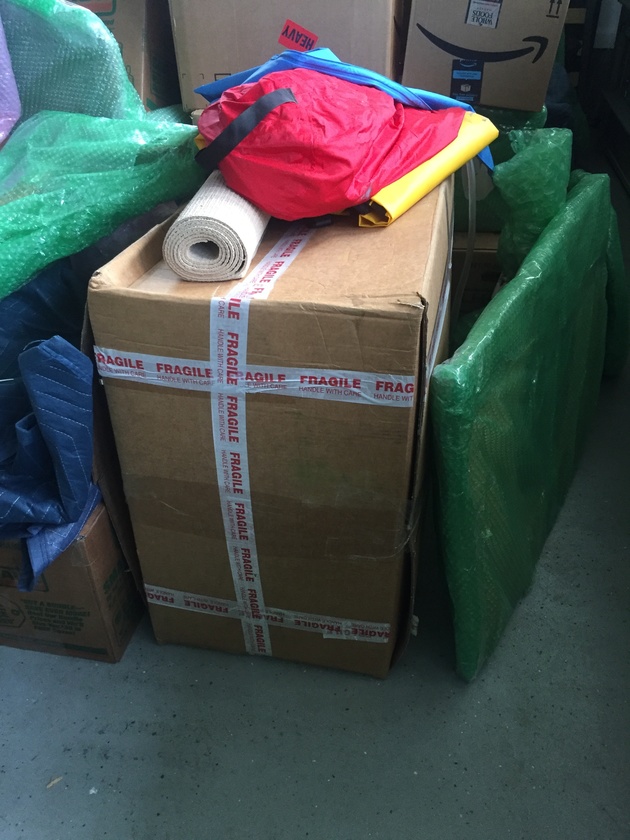A pindrafter is a magical machine. Top flows through from front to back, through a series of combs that rotate on the top and bottom, then through 2 rollers on the top and bottom and into a steel tube to the coiler where it's tucked cleanly into a bag in a can.
It works like a combination of a spinner's hands and hand cards. The rotating combs hold back and draft out the fiber while they simultaneously help the fibers blend together. I also have to use something very like a orifice hook to help thread it at the start of a new run. Except it's a delicate balance between running the machine slow enough not to wrap on the front rollers while also fast enough to feed into the can. That moment when the top is picked up & flows perfectly is one of magical relief. It's also when the fun begins!
Watching fiber flow through is very enjoyable but is also fraught with danger. Seeing fibers transform as they combine into a new whole is very rewarding, but it also requires meticulous attention to detail to make sure that nothing goes wrong. If there isn't enough humidity, too much static can build up. It's not fun at all when this causes fiber to wrap around part of the machine, and it's sad too. The wrapped fiber is automatically "waste", since it has to be separated from the whole to fix the problem. Plus there's the risk of damage to the machine, which can be expensive to fix. Sometimes fixing a wrap is fast, but other times it means that we have to stop processing until we can fix the problem.
Wrapped fibers can be very fast to clear if we catch them fast enough and if the wrap happens in a place that's easy to clear. A very bad wrap in the wrong place means that we have to completely shut down, since we have to take the machine apart to clear the wrap. If its simply a matter of clearing the wrap, it can take minutes to days to fix depending on where the wrap happened and how much, if anything, we need to take apart. In the extremely rare case that something breaks, it can take even longer since we first need to determine what went wrong, wait for parts and then install them. Typically this takes a few weeks, but we've had instances where it took a couple of months to get parts in so we could reinstall them & get back to processing.
When fiber wraps, its always a sign that something isn't quite right. Most often it means that there isn't enough humidity in the mill. More rarely it's a sign that there's too much humidity. So we need to either turn up our humidification system or give the fiber more time to absorb humidity. On the one hand we can read the humidity gauge in the mill, but we also have to feel the fiber. Happy fiber that's absorbed enough humidity has a very specific feel to it that's hard to put into words.
You see, it turns out that my high school physics teacher was right. Everything is physics! In this case, the friction of the fiber moving through the machine robs it of moisture which makes it staticy. Kinda like a really bad hair day, but magnified by an inflexible machine. The machine itself can make this worse, if those rotating combs called faller bars are made of plastic and metal or are just solid metal. Metal is better, since it's not prone to building up a static charge the way plastic is. Some pretty ugly things happen with plastic & metal faller bars and fine fibers...ask us how we know! 😃
Fine fibers are inherently more delicate, but the actual structure of the fiber can present unique challenges too. For instance yak and angora are both fairly short and slippery and don't have the same cohesion that rambouillet or merino wool has. The first few passes when blending with either of these fibers are particularly challenging, since they behave like themselves and not parts of a greater whole. Yak will travel through the pindrafter at a slightly different speed than merino, and if there isn't enough humidity to help hold these fibers together odds are pretty good that they'll wrap. So the machine needs to run very slowly at first. Eventually they blend more evenly and the merino helps carry the shorter, more slippery yak along with it.
Then there's the matter of speed, since speed can either help or hurt in blending. Some blends run through beautifully at higher speeds. Other blends, especially those with slippery fibers, have to be run at agonizingly slow speeds at first. Especially during colder parts of the year when we need to run our humidification system at its maximum capacity, just to be able to blend at all. When it's warmer out we can run the same blend at double the speed since the fibers absorb critical moisture so much easier when it's warmer out. For example I can run 14.5um merino/yak at double the speed in October than I can in March. Even with our heating & humidification systems, we just can't fool the fiber into absorbing moisture in March as well as it does in October. In very rare cases, some fibers just aren't happy during colder weather and we have to wait until warmer weather to be able to blend with them. Case in point is our merino/rose blend, since cellulose fibers like rose are so slippery by nature and so different from merino wool.
Our 14.5um merino/yak blend is an excellent example. The merino is very fine with good curvature and a smoother scale than most merino. Yak has a shorter staple length, less curvature and is naturally slightly slippery. They're similar enough in staple length & structure that the finished yarn will wear well, but they're just different enough to present some real challenges during processing.
At first the difference in staple length & how smooth the fibers are can make them prone to travel through the machine at slightly different speeds. This isn't as much of an issue during warmer month, but we have to run our humidification system at is maximum during colder months just to be able to process it. Even then we can only run our machine at half the speed that we could when it was warmer. So the same run that takes 1 hour in October takes 2 hours in March. That time adds up fast when we're making large runs, and every blend needs to go through the pindrafter many times to blend the fibers evenly so the final blended top basically spins itself.
This is some 14.5um merino/brown yak that wrapped during processing. It was cold out and the fiber decided to not play nicely, even with the humidification system turned up all the way. In the 2nd pass wrap, you can see how the yak is kind of just on top of the merino. They aren't really blended yet. By contrast the 5th pass wrap has both fiber blended pretty evenly. I was able to run the 5th pass a little faster than the 2nd, but not nearly as fast as I could when it was warmer outside. The fibers are pretty evenly blended here but not quite as even as I'd like to see.
The other difference between these 2 wraps is where they happened & why. The 2nd pass wrap happened around the front roller, since a little bit of shorter yak decided to not play nicely & took a bunch of fiber with it. It was pretty easy to clear this. The 5th pass wrap happened around the entire top set of the faller bars, essentially locking them in place. I caught it fast enough to prevent major damage to the machine, but not fast enough to prevent the wrap from happening. This wrap happened in part because of humidity challenges but mainly for another reason. Eventually fibers & dust from the fibers build up so the machine has to be cleaned. So I had to take apart the top set of faller bars & replace them, which took an hour or so. Not too bad, but enough to stop processing for that day.
That's the other dirty little secret about fiber processing: the machines need regular cleaning so they can function properly. Even if its warm outside & the humidity is optimal, the machines have to be clean so they blend easily. Plus its just good practice to keep them clean, since that minimizes wear. Its no different than making sure a loom is in working order or that your drive bands are in good shape and things are lubricated appropriately on a spinning wheel.
Hopefully you enjoyed this. Questions?

One of the key differences between cellulose fibers and wool is elasticity. Wool has a ton of curvature & crimp and its SO bouncy. Cellulose fibers are flat. They’re super soft & have amazing drape but essentially have no elasticity.
Check out how this Rambouillet/Angora yarn stretches so much farther than the Pearl/Seacell/Angelina. WOW!
How can the exact same blend make yarns that look & behave differently? There are different types of spinning frames, which affects how the yarn itself will spin. This is how these 2 yarns can both be DK weight but have very different yardage.
Then there’s how the yarn is finished. Some mills will wash & steam yarn after its spun, while others may just steam it. These yarns are from different mills that have their own processes for finishing yarn. Washing the one on the right will make it super fluffy.
Washing a yarn can transform it in surprising ways. This Mixed BFL/Rambouillet yarn transforms when its been washed & dyed. Why? Sometimes there’s some dirt left over after wool has been scoured & processed. Washing it gets any remaining stuff out and really can help a yarn come alive. This is a very gentle example of fulling, since simply adding some water fluffed the yarn up.
What yarns might not full? What yarns are made from fibers that have been specially processed to resist felting? Superwashed yarns. You can see here that these dyed Superwash Merino/Faux Cashmere yarns that I treated the same way as the Mixed BFL/Rambouillet yarns are equally bouncy as the undyed yarn.
Its so amazing how something as basic as water can give life to some fibers. This is one reason why its so important to swatch before starting a project.
I'm so excited to tell you that we're settled in and our website is open again for orders. The move was quite the adventure and its wonderful to finally be home and unpacked. These are a couple photos from December 8, showing the unpacking process. The box with the red & white tape has our mill computer on it. This computer is set up with Linux Mint & Express VPN as part of our cybersecurity strategy. Having to pack this computer was part 1 of why we had to pause online sales. We have other computers, but this is our only Linux computer. While we could have used another computer, we feel the potential cybersecurity risk wasn't worth it.
The next part was packing our current inventory. That had to go into a container of its own for transport down here to Florida. Then came the process of unpacking everything. When we're making top or blends, we use plastic cans to help hold the fiber as its going through the machine. They also work really well as packing containers! Between the cans & ...
I’m really excited that I can finally fill you in on our biggest project yet, the one I’ve been hinting at and the reason why we’ve been so quiet. We’re going to be moving south to Florida! We’re doing this for several reasons, most importantly being that the climate down south is a lot friendlier for fiber processing and that same climate is a lot better for my health. I have basically had to figure things out myself with some pretty serious health issues, since it seems like the entire world has gone insane and the doctors up here can’t think critically anymore. Its a sad state of affairs, but it’s turned out to be a good thing since my health has been the primary motivator to us moving. I’m really, really looking forward to living in a place where I can be healthier and also be able to process fiber without having to battle so hard for enough humidity.
We are going to be at Rhinebeck this year, virtually, and we’ll be kicking that off within the next few days. We ...
Today is the day where I put the finishing touches on our brand new website! While it might not be the prettiest site, it is a lot more secure and faster too. This is phase 1 of the site if you will, a very stable, secure bare bones site that's not very pretty but is extremely functional.
In phase 2, we'll be adding a beautiful theme so its as pretty as it is stable & secure. We also have plans to make international ordering a lot easier. Right now, spinning performance videos are linked on top & blend pages. In the future, we'll be able to embed them right on the product pages.
The best part of our new ecommerce platform is how easy customization is. The downside to that is the amount of time it takes to do the customizations. The issue of time is why we're rolling this new site out in phases, since doing everything that we want to do right now will take too much time. Stability, speed & security are going to have to take precedence over aesthetics. At least for now.
This is a ...















